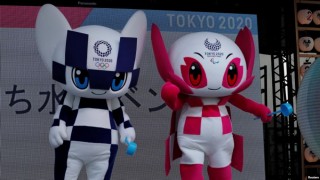Loading
Search
▼ Japan to Use Robot Assistants in 2020 Olympics
- Category:Other
A robot designed to carry things moves quickly across a field to gather equipment at a sports event. The equipment, like javelins and discuses, had been thrown by competitors.
Another robot moves a human sized screen on wheels. It is designed to permit virtual attendance at the event.
And, then there are the robots designed to look like the smiling, friendly creatures or mascots that act as Olympic Games representatives.
All these robots are part of preparations for the 2020 Olympic Games, in Tokyo, Japan.
Japanese car maker Toyota Motor Corporation presented the machines to reporters earlier this week. Toyota is a major supporter of the 2020 Olympic Games.
The mascot robots have moving arms and legs, and their eyes change to the image of stars and hearts. They cannot speak at all or walk very well. But Tomohisa Moridaira, lead engineer, suggested several possibilities, such as getting the robot to hold the Olympic torch using magnets.
The “field support robot” is a small bus-shaped machine based on a Toyota ride-sharing vehicle still in development.
The field support robot can travel as fast as 20 kilometers per hour. It holds three cameras and one special sensor that lets it “see” its surroundings. Around the top of its body are special lights that brighten when the vehicle is active. Its artificial intelligence helps it avoid barriers. It is also able to vary its path in order to protect areas of grass.
However, it cannot go find the objects, which can weigh up to eight kilograms, or pick them up on its own. A person has to travel with the device, pick up the objects and put them in it.
Then, with a press of a button, the vehicles transport the equipment where it needs to go.
Takeshi Kuwabara supervised the robot’s development. He said it is designed to team robots and humans.
“Our aim was to leverage the strengths of both humans and robots,” he said.
Toyota’s robotics center in the United States developed the moving screen known as the T-TR1. It takes the car maker’s usual business of transportation to another level. It is a moving human-sized screen designed to represent people who cannot physically attend the games.
Like all the world’s major car makers, Toyota uses robotics in production sites. But it has also designed human-like robots, including those that play musical instruments.
The Cue 3 is Toyota’s basketball-throwing robot. The general size and shape of a human, the Cue 3 sensors compute a three dimensional image of the basketball court the robot is in. Then its motors use that information to correctly angle the ball and determine the amount of force needed to shoot it into the basket. In other words, it scores a goal.
The Cue 3 is very good at this. The organization Guinness World Records recently honored it on its list for making 2,020 baskets in a row.
Toyota had already developed a large group of robots on wheels to perform house duties for old people and hospital patients. These machines will now also guide disabled guests to seating at the Olympics. The robots will also serve food and drinks at events.
The car maker plans to use the games to present its new vehicle technologies. These include buses fueled by a special kind of battery, and self-driving taxis. Toyota is competing with other car makers and technology companies to develop low cost, robot-controlled cars and electric vehicles.
The use of small cars to gather equipment at Olympics throwing events goes back to the 2008 Beijing Games. There, bright red, rocket-shaped cars collected objects like javelins and discuses.
At the 2012 London Games, the car maker BMW developed and operated a group of blue and orange smaller Mini Coopers to collect equipment. Small green robotic trucks performed the duty at the Rio games in 2016.
By Pete Musto and Caty Weaver.
- July 26, 2019
- Comment (0)
- Trackback(0)


